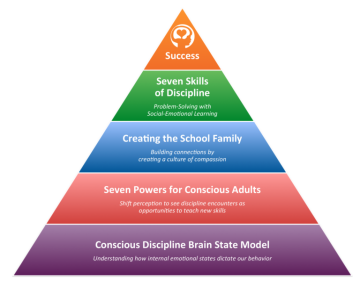Great Valley Academy continuously strives to identify tools and programs that impact students and parents in social-emotional learning. Conscious Discipline has received high ratings in 8 of 10 categories in a Harvard analysis of the nation’s top 25 social-emotional learning programs. The Harvard study’s authors say, “Conscious Discipline provides an array of behavior management strategies and classroom structures that teachers can use to turn everyday situations into learning opportunities.”
Conscious Discipline
Methodology
Conscious Discipline's core methodology is based on four essential components that are scientifically and practically designed for success.
Brain State Model
Conscious Discipline empowers us to be conscious of brain-body states in ourselves and children. It then provides us with the practical skills we need to manage our thoughts, feeling and actions.
With this ability to self-regulate, we are then able to teach children to do the same. By doing this, we help children who are physically aggressive (survival state) or verbally aggressive (emotional state) become more integrated so they can learn and use problem-solving skills (executive state). When we understand the brain state model, we can clearly see the importance of building our homes, schools and businesses on the core principles of safety, connection and problem-solving.
Survival State - "Am I safe?"
THE ONLY WAY TO SOOTHE THE SURVIVAL STATE IS THROUGH THE CREATION OF SAFETY.
In a survival state where we feel triggered by threat, these skills are flight, fight or surrender. We can’t think clearly to add 45 plus 68 when a tiger is chasing us. In the modern world, the tiger may be a disrespectful child, but our brain’s evolutionary skill set is the same: fight, flight or surrender.
Emotional State - "Am I loved?"
THE ONLY WAY TO SOOTHE AN UPSET EMOTIONAL STATE IS THROUGH THE CREATION OF CONNECTION.
Emotional State is our response to upset – and can only be soothed through connection. An upset emotional state is triggered by the world not going our way. It limits our ability to see from another’s point of view. This upset, unconscious state keeps us on autopilot so our words and tone match those of key authority figures from our childhood. We revert to disciplining the same ways we were disciplined, even if we know these behaviors to be ineffective or hurtful.
Executive State - "What can I learn?"
THE EXECUTIVE STATE IS THE OPTIMAL STATE OF PROBLEM-SOLVING AND LEARNING.
Conscious Discipline empowers us to be conscious of brain-body states in ourselves and children. It then provides us with the practical skills we need to manage our thoughts, feeling and actions. With this ability to self-regulate, we are able to teach children to do the same. By doing this, we help children who are physically aggressive (survival state) or verbally aggressive (emotional state) become more integrated so they can learn and use problem-solving skills (executive state). When we understand the brain state model, we can clearly see the importance of building our homes, schools and businesses on the core principles of safety, connection and problem-solving.
Executive State is the optimal state for problem-solving and learning. As we learn to regulate and integrate our internal state to be one of relaxed alertness, we are able access our own brilliance. We are empowered to change and make wise choices. An integrated executive state frees us from past conditioning, attunes us to the feelings and experiences of others, enables us to remain focused enough to set and achieve goals, and allows us to consciously respond instead of automatically react to life events.
Retrieved from www.consciousdiscipline.com
Resources for Parents
Direct Links


